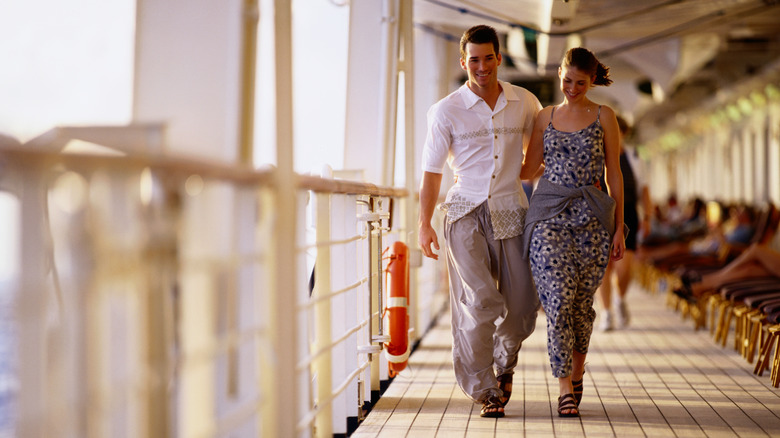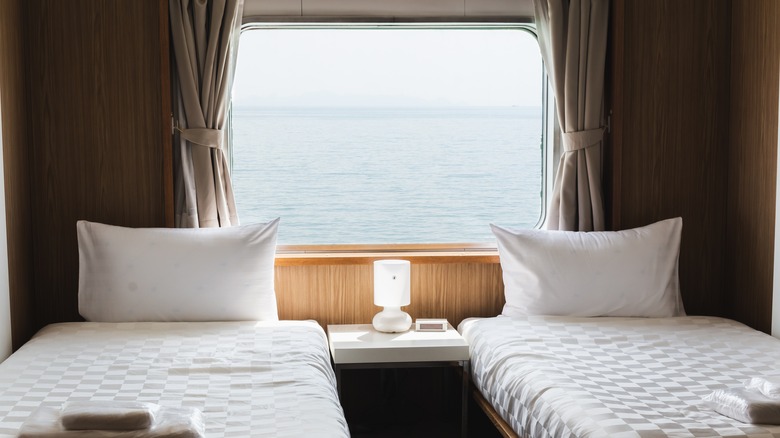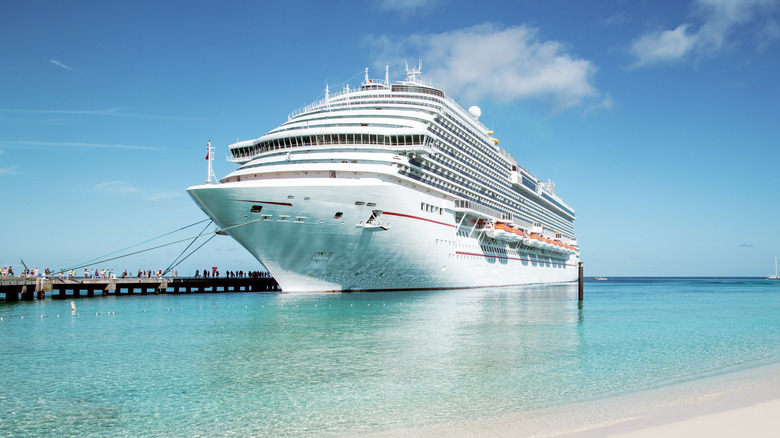The Best Cabin To Book On A Cruise If You Get Seasick
Even among ocean-faring regulars, seasickness is bound to happen from time to time. It can turn a relaxing getaway into a bit of a nightmare with symptoms of dizziness, nausea, vomiting, and even vertigo. If you've ever felt ill while moving in a car, plane, or theme park ride, you could be more prone to getting seasick on a cruise ship. In that case, your best bet is to book a stateroom in the middle of the vessel (also known as the midship) on a lower deck.
The higher up on a cruise ship you are, the more you'll feel the rocking motion of the waves and wind. The lower and more centralized you are, the more stable your cruise experience is going will be. Ideally, you'd book a room with a porthole, as sea sickness is caused by an incongruence between your senses.
When you go up and down with the waves, the inner ear sends the message to the brain, "Hey, the world is moving." However, if you're inside an interior cabin watching the room move around with you, the eyes get confused and send the message, "Wait, no it's not." This conflict causes a spike in stress hormones, leading to common seasickness symptoms. However, if you have a window, it can help your eyes make sense of the motion, recalibrating your brain and body.
Best alternative to the midship
If you suspect seasickness could be an issue, it's best to reserve a specific cabin. While booking a guarantee might offer the best deal for travelers on a budget, you may end up in a less-than-ideal location. If midship rooms are unavailable, any room on the lower deck is a good alternative. The closer you are to ocean level, the less likely you are to bob up and down in poor weather. A room with a balcony is always a good idea, as you can get some fresh air when symptoms peak. The drawback to the lower deck is that you will be closer to the engine and the crew areas, so it may be tricky for light sleepers.
It's best to avoid the higher decks and the front of the ship. While they offer the best views and close proximity to restaurants and entertainment, they are prone to the most movement from plowing through the wind and the waves head-on. If you'd prefer to stay close to the action, at least book a midship room on an upper deck. If you book a room with a balcony near the front, keep in mind that it could be too windy when you need a breath of fresh air. In that case, you can always use the elevator to head to lower levels if your symptoms flare up.
More tips to combat seasickness
In the cruise-planning stage, look for deals with modern cruise ships built with stabilizers, which are fins or rotors that unfold underwater to reduce movement. They operate the same way as airplane wings, keeping the ship stable through turbulence or, in this case, choppy water. Many modern cruise ships are equipped with this technology, especially mega-ships with 1,500 rooms or more. Smaller and older ships, on the other hand, may leave you feeling a bit queasy.
You'll also want to consider the route and time of year. The weather may not be as forgiving during hurricane season in the Caribbean, which is June through November. If a cruise ship to see the aurora borealis is on your bucket list, the northern seas in the middle of the winter could prove to be a bit stormy. If you fancy a getaway to Antarctica, you may want to fly instead of sail, as the Drake Passage has swells that can reach up to 65 feet, sending even the bravest of TikTokers back to bed.
Once you pick your ideal cruise, pack some seasickness medication. Another classic trick is to sip on ginger ale and peppermint candies, both of which can aid nausea. The good news is seasickness is a temporary ailment. As soon as you get your "sea legs" — the nautical term for getting used to the rocking — your body will return to equilibrium. That way, you can actually enjoy the cruise you paid for.


